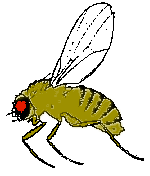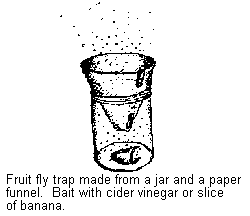Fruit Flies
ENTFACT-621: Fruit Flies | Download PDF | En Español
by Michael F. Potter, Extension Entomologist
University of Kentucky College of Agriculture

Fruit Fly
If you have been seeing small flies or gnats in your kitchen, they're probably fruit flies. Fruit flies can be a problem year round, but are especially common during late summer/fall because they are attracted to ripened or fermenting fruits and vegetables.
Tomatoes, melons, squash, grapes and other perishable items brought in from the garden are often the cause of an infestation developing indoors. Fruit flies are also attracted to rotting bananas, potatoes, onions and other unrefrigerated produce purchased at the grocery store. This fact sheet will explain how infestations originate and how they can be prevented in your home or place of business.
Biology and Behavior
Fruit flies are common in homes, restaurants, supermarkets and wherever else food is allowed to rot and ferment. Adults are about 1/8 inch long and usually have red eyes. The front portion of the body is tan and the rear portion is black. Fruit flies lay their eggs near the surface of fermenting foods or other moist, organic materials. Upon emerging, the tiny larvae continue to feed near the surface of the fermenting mass. This surface-feeding characteristic of the larvae is significant in that damaged or over-ripened portions of fruits and vegetables can be cut away without having to discard the remainder for fear of retaining any developing larvae. The reproductive potential of fruit flies is enormous; given the opportunity, they will lay about 500 eggs. The entire lifecycle from egg to adult can be completed in about a week.
Fruit flies are especially attracted to ripened fruits and vegetables in the kitchen. But they also will breed in drains, garbage disposals, empty bottles and cans, trash containers, mops and cleaning rags. All that is needed for development is a moist film of fermenting material. Infestations can originate from over-ripened fruits or vegetables that were previously infested and brought into the home. The adults can also fly in from outside through inadequately screened windows and doors.
Fruit flies are primarily nuisance pests. However, they also have the potential to contaminate food with bacteria and other disease-producing organisms.
Prevention
The best way to avoid problems with fruit flies is to eliminate sources of attraction. Produce which has ripened should be eaten, discarded or refrigerated. Cracked or damaged portions of fruits and vegetables should be cut away and discarded in the event that eggs or larvae are present in the wounded area. A single rotting potato or onion forgotten at the back of a closet, or fruit juice spillage under a refrigerator can breed thousands of fruit flies. So can a recycling bin stored in the basement which is never emptied or cleaned.
People who can their own fruits and vegetables, or make wine, cider or beer should ensure that the containers are well sealed; otherwise, fruit flies will lay their eggs under the lid and the tiny larvae will enter the container upon hatching. Windows and doors should be equipped with tight-fitting (16 mesh) screens to help prevent adult fruit flies from entering from outdoors.
Eradication
Once a structure is infested with fruit flies, all potential breeding areas must be located and eliminated. Unless the breeding sites are removed or cleaned, the problem will continue no matter how often insecticides are applied to control the adults. Finding the source(s) of attraction and breeding can be very challenging and often will require much thought and persistence. Potential breeding sites which are inaccessible (e.g., garbage disposals and drains) can be inspected by taping a clear plastic food storage bag over the opening overnight. If flies are breeding in these areas, the adults will emerge and be caught in the bag.
After the source of attraction and breeding is eliminated, a pyrethrum-based, aerosol insecticide may be used to kill any remaining adult flies in the area.

Fruit Fly Trap
A better approach, however, is to construct a trap by placing a paper funnel (rolled from a sheet of notebook paper) into a jar which is then baited with a few ounces of cider vinegar. Place the jar trap(s) wherever fruit flies are seen. This simple but effective trap will soon catch any remaining adult flies which can then be killed or released outdoors.
Revised: 1/94
CAUTION! Pesticide recommendations in this publication are registered for use in Kentucky, USA ONLY! The use of some products may not be legal in your state or country. Please check with your local county agent or regulatory official before using any pesticide mentioned in this publication.
Of course, ALWAYS READ AND FOLLOW LABEL DIRECTIONS FOR SAFE USE OF ANY PESTICIDE!
Images: University of Kentucky Entomology
